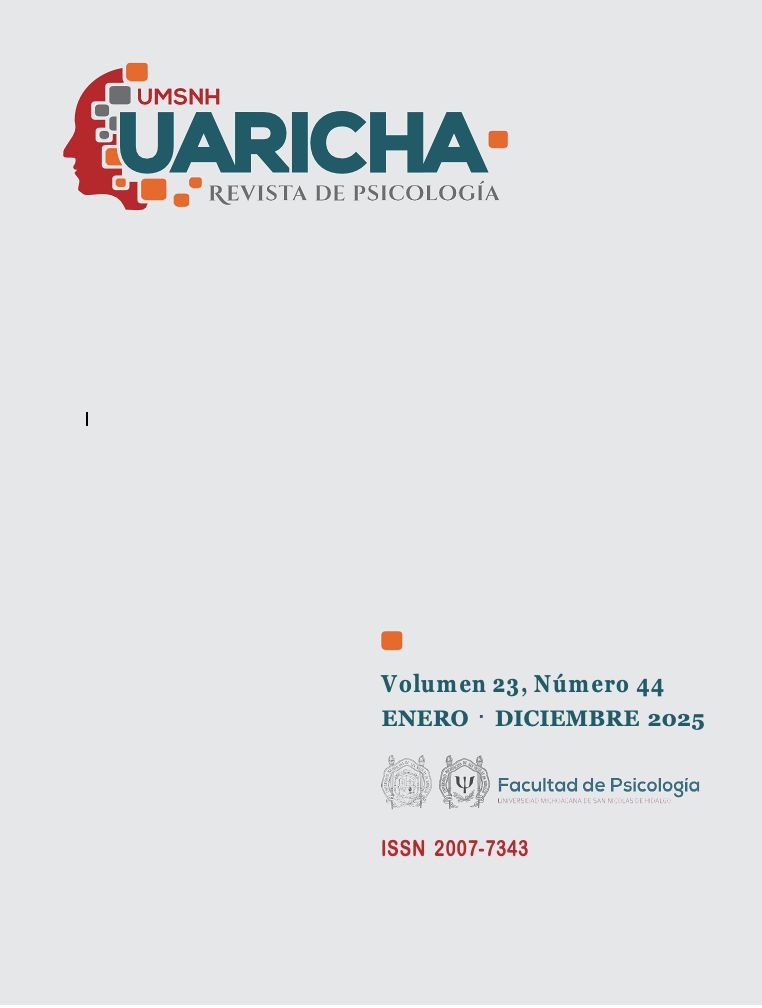Between footprints and hearts: Autoethnographic journeys in interspecies family
Main Article Content
Abstract
Interspecies families, inspired by Donna Haraway's perspective, rethink the role of nonhuman animals in everyday life, not only as companions, but also as active agents in the construction of bonds. The evolution of family structures has transcended traditional models, giving way to more diverse configurations, such as multi-species families. These new dynamics require an expanded therapeutic perspective, integrating research-based interventions to respond to their changing needs. This shift reflects a profound transformation in the way we relate to companion animals. Far from being considered mere possessions, they have become full members of the family, with a significant impact on the emotional and social wellbeing of their caregivers. From an autoethnographic approach, this study explores the experiences and meanings constructed around living with nonhuman animals in interspecies families. Through personal narratives, the emotional and ethical complexities of collaborative care are unveiled, showing how the redefinition of family ties opens the way to new forms of relationships. This work not only documents a paradigm shift but also seeks to understand how these relationships influence the configuration of roles, affective dynamics and processes of emotional well-being. Objective: To explore and analyze, through an autoethnographic approach, the coexistence with non-human animals in interspecies families and its impact on family structure and functionality.
Article Details
Issue
Section

This work is licensed under a Creative Commons Attribution-NonCommercial-NoDerivatives 4.0 International License.
The authors have the right to ownership or copyright and they give to "Uaricha Psychology Magazine" the right to publish for the first time the article, as well as disclose and distribute it on the technological available media and through repositories.
Uaricha Psychology Magazine, is a quarterly publication, published by the Psychology College of the "Universidad Michoacana de San Nicolás de Hidalgo", Street Francisco Villa No. 450, Col. Dr. Miguel Silva, Morelia, Michoacán, P. C. 58110. Phone (+52) 443 312 9909, ext. 149, www.revistauaricha.umich.mx, uaricha.publicaciones@umich.mx. Responsible publisher: Roberto Oropeza Tena. Reserve of exclusive use rights No. 04-2013-070413365500-203, e-ISSN: 2007-7343, Granted by the National Institute Copyright. Responsible of the last update of this number, Computer center of the Psychology College, Ing. Erick Vidar Alva Rangel.
How to Cite
References
Agudelo Bedoya, M. E., & Estrada Arango, P. (2015). Realidades familiares que cambian: Invitación a nuevas comprensiones. https://api.semanticscholar.org/CorpusID:171110694
Aragunde-Kohl, U., Gómez-Galán, J., Lázaro-Pérez, C., & Martínez-López, J. Á. (2020). Interaction and Emotional Connection with Pets: A Descriptive Analysis from Puerto Rico. Animals, 10(11), 2136. https://doi.org/10.3390/ani10112136
Blanco, M. (2017). Investigación Narrativa y Autoetnografía: Semejanzas y Diferencias. Investigación Cualitativa, 2(1), 66–80. https://doi.org/10.23935/2016/01037
Brandes, S. (2020). Batallas de custodia trans-especie y la reformulación de lazos de familia. Disparidades. Revista de Antropología, 75(1), 009. https://doi.org/10.3989/dra.2020.009
Bures, R. M. (2021). Integrating Pets into the Family Life Cycle (pp. 11–23). https://doi.org/10.1007/978-3-030-64085-9_2
Cain, A. O. (1985). Pets as Family Members. Marriage & Family Review, 8(3–4), 5–10. https://doi.org/10.1300/J002v08n03_02
Cammaert, A., & María., A. (2013). Procesos de transformación en la terapia: una explicación a la pregunta por cómo ocurrió el cambio. https://api.semanticscholar.org/CorpusID:147394332
Carr, A. (2020). Evidence for the Efficacy and Effectiveness of Systemic Family Therapy. En The Handbook of Systemic Family Therapy (pp. 119–146). Wiley. https://doi.org/10.1002/9781119438519.ch6
Díaz Videla, M. (2015). El miembro no humano de la familia: las mascotas a través del ciclo vital familiar. Revista Ciencia Animal, 1(9), 83–98. https://ciencia.lasalle.edu.co/ca
Diaz Videla, M. (2019). El valor de la vida de los animales de compañía. Revista Latinoamericana de Estudios Críticos de Animales, 1(6).
Doré, A., Michalon, J., & Monteiro, T. L. (2019). The Place and Effect of Animals in Families. Enfances Familles Générations, 32. https://journals.openedition.org/efg/8073#text
Faver, C. A., & Cavazos, A. M. (2008). Love, Safety, and Companionship: The Human-Animal Bond and Latino Families. Journal of Family Social Work, 11(3), 254–271. https://doi.org/10.1080/10522150802292350
Ferguson, S. (2018). “I just don’t feel like myself anymore”: putting the patient’s voice into integrated care. European Journal of Marketing, 52(11), 2207–2213. https://doi.org/10.1108/EJM-12-2016-0825
Haraway, D. (2019). Cuando las especies se encuentran: introducciones. Tabula Rasa, 31. https://doi.org/10.25058/20112742.n31.02
INEGI. (2021). Encuesta Nacional de Bienestar Autorreportado.
Lindström, M., & Isaksson, G. (2017). Personalized Occupational Transformations: Narratives from Two Occupational Therapists’ Experiences with Complex Therapeutic Processes. Occupational Therapy in Mental Health, 33(1), 15–30. https://doi.org/10.1080/0164212X.2016.1194243
Linne, J., & Angilletta, F. (2023). Pet Families. Modos de leer nuevas formas de vivir juntos. Estudios Sociológicos de El Colegio de México, 41(123), 667–698. https://doi.org/10.24201/es.2023v41n123.2344
McGoldrick, M. (2018). The genogram casebook: A clinical companion to genograms: Assessment and intervention. En Journal of Marital and Family Therapy, 44 (2). Norton &; Company. https://doi.org/10.1111/jmft.12315
Monfort Montolio, M., & Sancho-Pelluz, J. (2020). Animal-Assisted Therapy in the Residential Treatment of Dual Pathology. International Journal of Environmental Research and Public Health, 17(1). https://doi.org/10.3390/ijerph17010120
Reyes Plazaola, P. T., & Díaz Videla, M. (2021). Trastornos psiquiátricos del vínculo humano-animal: psicopatologías del afecto hacia los animales de compañía. Revista de Psicología, 094. https://doi.org/10.24215/2422572xe094
Rodríguez Ceberio, M., & Díaz Videla, M. (2020). Las mascotas en el genograma familiar. Ciencias Psicológicas, 14(1), 1–16. https://doi.org/10.22235/cp.v14i1.2112
Sáez-Olmos, J., Caravaca-Llamas, C., & Molina-Cano, J. (2023). La familia multiespecie: cuestión y reto multidisciplinar * The multispecies family: multidisciplinary issue and challenge. Aposta, revista de ciencias sociales, 97, 8–27. http://apostadigital.com/revistav3/hemeroteca/jsaezol.pdf
Sandøe, P., Corr, S., & Palmer, C. (2016). Companion Animal Ethics (Universities Federation for Animal Welfare, Ed.; 1a ed.).
Silva, N. B., & Osório, F. L. (2018). Impact of an animalassisted therapy program on physiological and psychosocial variables of pediatric oncology patients. PLOS ONE, 13(4), e0194731. https://doi.org/10.1371/journal.pone.0194731
Tomlinson, C. A., Matijczak, A., McDonald, S. E., & Gee, N. R. (2023). The role of human-animal interaction in child and adolescent health and development. En Encyclopedia of Child and Adolescent Health (pp. 564–577). Elsevier. https://doi.org/10.1016/B978-0-12-818872-9.00003-0
Wrobel, E. K. (2014). Life Experience as a Catalyst for Therapeutic Change. https://sophia.stkate.edu/msw_papers/413
Zurita, N., & Carrillo, M. L. (2010). Guía de actividades para terapia asistida con animales (caballos y canes) para desarrollar la psicomotricidad en niños con síndrome de Down en edades de 3 – 6 años. Universidad Politécnica Salesiana.

